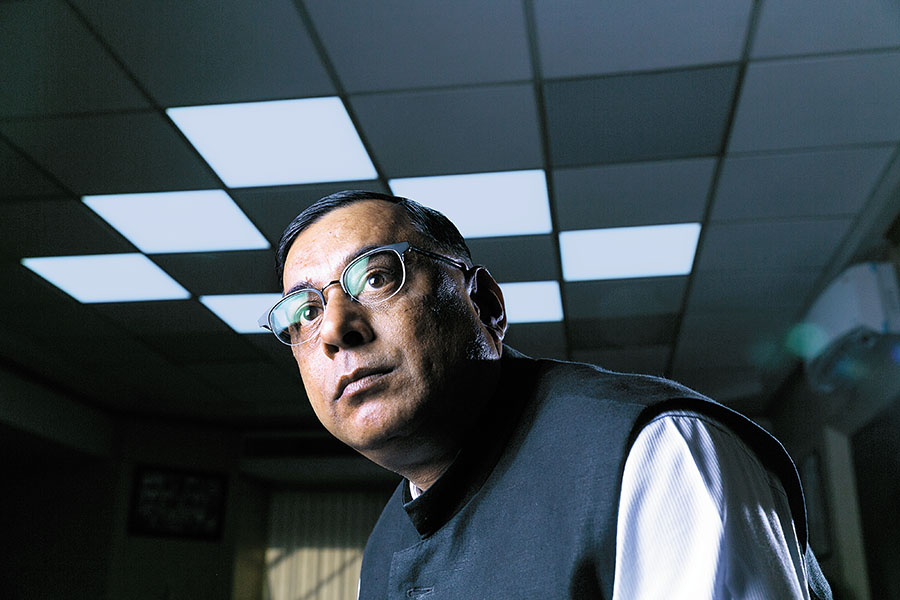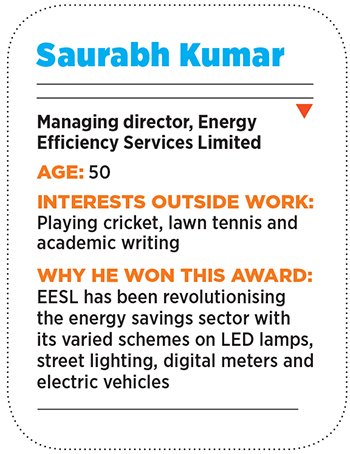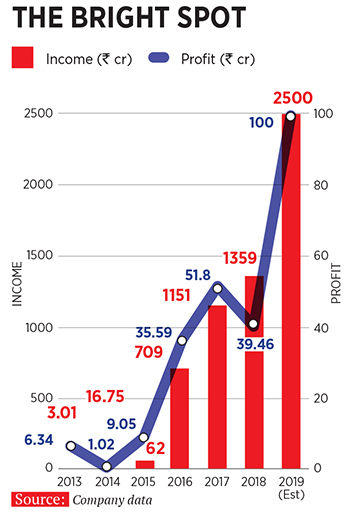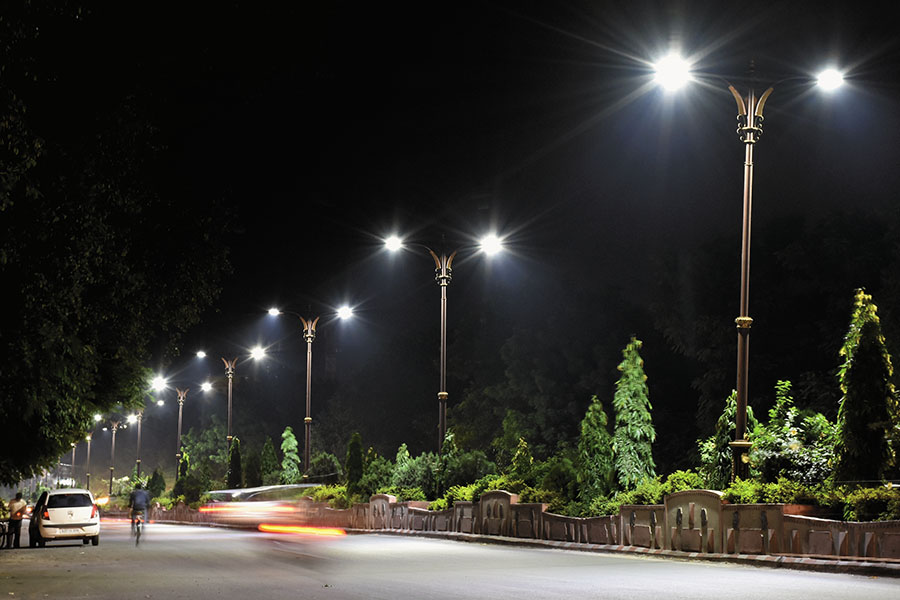
EESL: Lighting the way
Saurabh Kumar has taken the company from being a mere consultant to becoming one of the world's biggest energy efficiency service providers
 Saurabh Kumar, Managing Director, EESL
Saurabh Kumar, Managing Director, EESLForbes India Leadership Awards 2018: Best Company-Public Sector
Saurabh Kumar still vividly remembers the time he took charge as managing director of Energy Efficiency Services Limited (EESL). After all, six years isn’t really a long time.
In 2013, the Noida-headquartered public sector company—with financial backing from NTPC Limited, Power Finance Corporation, Rural Electrification Corporation, and Power Grid Corporation of India—was hardly what it was meant to be, relegated mostly to the job of consulting and helping state governments prepare their action plans on saving energy. With annual revenues of ₹5 crore, and a corpus of ₹90 crore, EESL had barely made any strides in energy savings, a job it was tasked with when, in 2009, it was established as a joint venture between the four public sector companies.

“The focus was on doing things related to consultancy. There were lots of states that were preparing their action plans and they were getting budgets. We did audits on behalf of the Bureau of Energy Efficiency,” says Kumar, 50, an IIT-Kanpur alumnus and a former officer of the Indian Revenue Service (IRS). “But it was not what we were created for. EESL got equity of ₹90 crore, and we weren’t utilising that. So we took a conscious decision as management that we will now focus on project implementation.”
In the past six years, EESL has gone from simply being a consultancy to becoming one of the world’s biggest energy efficiency service providers. By their own assessment, they have led to a combined savings of over ₹20,000 crore in Asia’s third-largest economy.
From operational revenues of ₹3 crore in 2013, the company now expects over ₹2,500 crore in 2019, with profits of ₹100 crore.
Over the past few years, the company has also been instrumental in reducing the price of energy efficient LED lamps by as much as 92 percent, making them more affordable; it has replaced incandescent street lights across the country with LED lamps; installed smart electric meters to improve billing efficiency; and is now foraying into the use and promotion of electric vehicles.
*****
EESL was formed as part of the Indian government’s plan to promote energy savings, because, Kumar says, in the long run energy efficiency pays for itself.
Between 2009 and 2013, EESL couldn’t come out with a product that could kickstart awareness on the energy efficiency front, and didn’t make much of an impact. All that changed when Kumar joined as its 13th employee in 2009. “So there was a task of doing something that was never done before,” he says. “There are very few instances in the world where scaling up of energy efficiency has ever happened.” EESL then went back to the drawing board to identify a product that can eventually be scaled up.
Initially called Domestic Efficient Lighting Programme (DELP), the idea was to replace incandescent bulbs with LED lamps at no upfront cost to the consumer. The consumer would pay ₹10 every month for seven years, and the money would be collected by the utility provider and repaid to EESL, who would buy LED lamps through an open bid. “For utility providers, there was no financial implication. It was a win-win situation for all stakeholders,” says Kumar. “But it still took us about a year to convince state governments, regulators and utility providers.”
In February 2014, EESL launched the first chapter of DELP in Puducherry, where it procured 6 lakh LED lamps, for ₹310 each. It set up kiosks at bill payment centres for consumers to see the product, and ran an awareness campaign. “In India, touch and feel are very important,” Kumar says. “While we can explain, and give power point presentations, the moment someone comes and sees this is working, scalability becomes possible.”

It was decided that each household in Puducherry would get three LED bulbs; this was ensured by adding the unique meter numbers of consumers to their system. “We wanted to limit our financial exposure and so did the discom, because it was contingent upon bill payments,” says Kumar. “And bill paying and collection efficiency in the country is not very high.”
Following the success of the programme in Puducherry, during which they sold about 6 lakh LED lamps, the Andhra Pradesh government gave an order of 60 lakh LED lamps to EESL. “The moment we launched a tender, the price of LED lamps became ₹159,” says Kumar. “With the 60-lakh order, the prices came to about ₹150. Other states also began to take notice, and obviously, the ministry of power started to realise it is a good thing. In May 2015, Prime Minister Narendra Modi launched a nationwide scheme called Ujala. And it just took off from there.”
By 2016, the price of LED lamps fell to about ₹40, and EESL was selling 6 lakh of them a day country-wide. So far, the company has sold 31.2 crore bulbs.
*****
EESL’s success with LED lamps paved the way for new opportunities. One of them came from the Andhra Pradesh government, after the state was hit by Cyclone Hudhud in October 2014. With much of the infrastructure in Vishakhapatnam and adjoining areas completely knocked down, the government had the mammoth task of reinstalling street lights. “The task was to set up 1 lakh LED street lamps in about four weeks. Before that, the maximum number of street lights that this company had installed was 250,” says Kumar.
EESL got down to business and managed everything from procurement to installation. “The state government did not expect a public sector company to work as quickly as we did,” Kumar recalls. “This made them confident, and they gave us an order of 6 lakh street lights. That changed everything.”
With the central government throwing its weight behind the programme through the Street Light National Programme to convert 3.5 crore street lamps to LED, many more states also undertook street lighting programmes. “Today we have done about 71 lakh street lights in the country. We are the largest company in the world to hold that many street light assets,” Kumar says.
Another new area EESL has ventured into is the refurbishing of lights, fans and air conditioners in government offices. “In a year’s time, we completed upgrades of about 10,000 government buildings in the country; it is not a small programme. One of our plans was to make all railway stations across the country have LED lighting. It was a mammoth task, and it was done within one year; it was completed in March 2018.”
*****
Over the past year, EESL has forayed into everything from smart electric meters to electric vehicles and solar power plants. In the solar power space, it has begun setting up mini solar plants in Maharashtra for agricultural consumption.
“We are trying to tackle a big issue—agricultural consumption—as far as discoms are concerned,” Kumar says. He adds: “For Maharashtra State Electricity Distribution Co Ltd, we had a unique proposition. They have 4,000 substations, and many of them have vacant land. We have taken that land on lease, free of cost, for 25 years with the aim of setting up mini power plants of 0.5 MW and 2 MW.” It has already commissioned about 10 MW, and plans to commission another 130 MW by March. Andhra Pradesh and Uttar Pradesh have also shown interest to implement a similar programme.
“ We didn’t have something that was given to us from day one. We had to fend for ourselves.”
Saurabh Kumar, Managing director, EESL
EESL is also rolling out digital meters in the country to increase efficiency and reduce leakage. The New Delhi Municipal Council has tasked EESL with replacing 75,000 meters with digital meters, and the company expects to complete the process by December. “The total billing efficiency in India is 83 percent,” Kumar says. “Last year, 1,300 billion units of electricity were sold; 17 percent of that is 200 billion units, which translates to ₹80,000 crore worth of electricity. The only way you can prevent this loss is through smart meters.”
EESL will own the meters, and do the necessary backend work of integration, software and data management. In return, the power distribution company pays a monthly rental of ₹70 per meter to EESL. “We told them that meter reading and management cost them ₹45 per month per meter, which they will now save. Now, if they account for the 17 percent gain in billing efficiency, they don’t need to pass on any extra cost to the consumer. On the contrary, they can reduce tariff.” EESL’s smart meter procurement has already brought down smart meter prices from ₹6,000 to ₹2,000. The company intends to replace 25 crore conventional meters with smart meters in India over the next few years.
EESL is also in the midst of buying and promoting electric vehicles (EV) in the country. Last year, it announced an intention to procure 10,000 EVs; Tata Motors and Mahindra & Mahindra jointly won the bid to sell EVs to the government. “In the next couple of months, 1,500 cars will be running in Delhi. Already about 300 to 400 cars are on the road,” Kumar says. These include 28 cars that were taken by the prime minister’s office, 25 vehicles by various ministries and over 70 by municipal bodies. EESL is pinning its hopes on two policies—regarding charging infrastructure and government incentives—that are work-in-progress to kickstart the EV boom in India. “Hopefully, in the next four months, all this will be in place,” Kumar says.
Over the past few months, EESL has also turned its attention to trigeneration (a combined process of generating electricity, and cooling and heating large facilities), and is targeting hospitals, hotels, and malls. Last year, the company acquired the UK-based Eidena Power for ₹493 crore to help with its trigeneration plans. “What we are offering is a 10 percent saving on electricity bills. With tariffs rising, the actual savings will only increase,” says Kumar. “The other advantage is captive power, which can keep grid fluctuations away.”
*****
Apart from innovation, Kumar credits the turn in the company’s fortunes to the diligent use of long-term and short-term funds. “For example, in the case of Ujala, the moment I sell a bulb, I realise my revenue. So we don’t fund Ujala from our medium- or long-term loans. I usually take working capital loans to fund Ujala. Then we have medium-term projects like street lamps and EVs, which have six- or seven-year payback periods. For those we take bonds of seven to eight years. For solar projects, we are now going to utilise the multilateral lines of credit that are 15 to 17 years.”
 Street lights installed by EESL in Udaipur, Rajasthan. The company has a total of 71 lakh street light assets across the country
Street lights installed by EESL in Udaipur, Rajasthan. The company has a total of 71 lakh street light assets across the countryAnd experts see no reasons to worry, at least in the immediate future. “Certainly, the future looks bright for EESL,” says Kanv Garg, director of renewables and electric mobility at consultancy firm EY. “They have emerged as the aggregator of aggregators, and have broken down price barriers. But, at some point, there also needs to be a hard assessment of the way forward. That is, if they simply want to reduce prices, or look at a sustainable ecosystem such as in the case of electric vehicles.”
Garg reckons that the company is also likely to foray into renewable energy financing at some point, to emerge as a non-banking finance company. “But, there needs to be a strong strategic intervention on improving their own internal capacity in terms of leadership beyond the current regime.”
Kumar, meanwhile, has resigned from the IRS to devote his entire attention to EESL. “I am a jack of all trades, but master of none,” he says. “I was the 13th employee of the company. Now we have 1,200 people working in 35 offices. Clearly, we have come a long way.”
(This story appears in the 07 December, 2018 issue of Forbes India. To visit our Archives, click here.)
Post Your Comment















